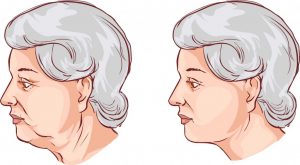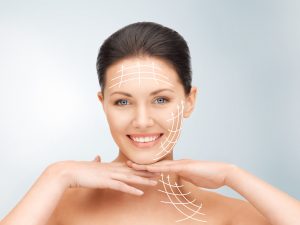
The loss of youthful contours in the face can be due to a variety of factors, including heredity, gravity, environmental conditions, and stress.
Facelift is a surgical procedure that improves visible signs of aging in the face and neck, such as:
- Sagging in the middle of your face
- Deep creases below the lower eyelids
- Deep creases along the nose extending to the corner of the mouth
- Fat that has fallen or has disappeared around mid face
- Loss of skin tone in the lower face that creates jowls
- Loose skin and excess fatty deposits under the chin and jaw can give even a person of normal weight the appearance of a double chin.

Rejuvenation procedures typically performed in conjunction with a facelift are:
- EYE BROW LIFT, to correct a sagging or deeply furrowed brow,
- NECK LIFT to rejuvenate neck and
- EYELID LIFT SURGERY to rejuvenate aging eyes.
- SMAS LIFTING to rejuvenate cheek and chin line
- AND a variety of other procedures that further enhance the outcome of a facelift. They include:
- Facial implants or fat transfer,
- Soft tissue augmentation to recontour the facial structure,
- Resurfacing techniques to improve the tone and texture of facial skin ,
- Wrinkle reduction by injection of fat or fillers

A facelift won’t change your fundamental appearance and cannot stop the aging process.
A facelift can only be performed surgically; non-surgical rejuvenation treatments cannot achieve the same results, but may help delay the time at which a facelift becomes appropriate and complement the results of surgery.
During your facelift consultation be prepared to discuss:
- Your surgical goals
- Medical conditions, drug allergies, and medical treatments
- Current medications, vitamins, herbal supplements, alcohol, tobacco, and drug use
- Previous surgeries
How is the facelift procedure?
A facelift procedure is performed under general anesthesia.
Depending on the degree of change you’d like to see, your facelift choices include:
- Face lifting with SMAS plication or
- Facelifting with SMAS ectomy or
- DEEP SMAS Lifting and\ or
- Neck lift
A traditional facelift : The incision often begins in the hairline at the upper part of ear continues around the ear and ends in the lower scalp. Fat may be sculpted or redistributed from the face, jowls and neck, and underlying tissue is repositioned, commonly the deeper layers of the face and the muscles are also lifted. Skin is redraped over the uplifted contours and excess skin is trimmed away.
A second incision under the chin may be necessary to further improve an aging neck. Sutures or skin adhesives close the incisions.
Another subgroup of traditional face lifting is DEEP PLANE FACE LIFTING. Please find detailed information regarding Deep Plane Face Lifting at the bottom of the page.
Short Scar Face Lifting: An alternative to a traditional facelift uses shorter incisions at the temples, continuing around the ear and possibly within the lower eyelids or under the upper lip.
In both techniques SMAS is manipulated and lifted to some degree. SMAS lifting is one of the key step in face lifting to generate a better result. The more extensive and durable results are obtained with DEEP PLANE SMAS LIFTING.

Sagging jowls, loose neck skin and fat accumulation under the chin may be corrected with a neck lift. The neck lift incision often begins in front of the ear lobe and wraps around behind the ear ending in the lower scalp.
Once healed, the incision lines from a facelift are well concealed within the hairline and in the natural creases of the face and ear.
The visible improvements of a facelift appear as swelling and bruising subside. Your final result should not only restore a more youthful and rested appearance, but also help you feel more confident about yourself. Get more information about facelift results.
Thin tubes may be present to drain any excess blood or fluid that may collect under the skin.
During your facelift recovery, a bandage might be placed around your face to minimize swelling and bruising once your procedure is completed.
You will be given specific instructions that may include how to care for the surgical site and drains, medications to apply or take orally to aid healing and reduce the potential for infection, specific concerns to look for at the surgical site or in your general health, and when to follow up with your plastic surgeon.
Recuperation and Healing
Patients go home with their heads and necks wrapped in dressings, which are usually removed the next day. Or they can stay in hospital overnight and go home with only a face corset the following day.
Minimal initial discomfort is easily controlled with oral medication.
All sutures are removed within 10 days. Bruising and swelling decrease to “socially acceptable” levels in 10 to 20 days.
The final result is evident in four to six weeks or sooner, with continued improvement for several months.
DEEP PLANE FACE LIFTING
A deep plane facelift differs significantly from the more commonly used SMAS-lifting techniques. The main difference in outcomes are that deep plane lifts can provide much more natural and long-lasting results plus there is less chance of scarring or complications. The most significant difference is that this type of lift can actually achieve rejuvenating change in the midface.
A deep plane lift typically requires more skill and training to be performed safely and properly. This is why it is a less commonly used technique worldwide. However, when performed by an expert, complication rates are the same or better than other techniques and results are substantially more impressive. Other SMAS lifting techniques focuses on skin pulling and removal. However, a deep plane facelift focuses on the release and movement of muscle, deep tethering bands and fat layers. This difference is the main philosophy of deep plane face lifting as by doing this you replace these layers back to a more natural and youthful position.
Similar to other SMAS-lifting techniques, limited access incisions are made around the ear. The skin is elevated only slightly. Then I dive under the SMAS-platysma complex in the “deep plane.” Deep plane term is used to describe the anatomical plane that exists between the SMAS-platysma complex (which is muscle and fascia) and the deeper layer of muscles responsible for facial expression. While some surgeons enter and release this layer only minimally, I prefer to perform a more comprehensive release.
In order to obtain the most significant and natural change, the condensed and dense tissues tethering this SMAS must be released from lateral to medial in order to achieve tension-free movement. This release allows the vertical replacement of the cheeks and fat pads. This effect does not seen with less demanding procedures. Moving the cheeks back to a more vertical position significantly restores a more youthful and heart shaped appearance to the aging face. Another advantage of this technique is that the maneuver immediately improves the hollowing and shadowing seen in the lower eyelids. Because moving the cheeks and fat pads I am restoring volume where it was lost by descent associated with aging.
We also perform a lateral release of the muscles in the neck as well. Releasing the tethering points in the lateral neck has also an impact on youthful appearance. Because elevating this layer provides much more significant rejuvenation and refinement of the neck and jawline with a longer lasting result. Some SMAS-lifting techniques can cause bunching and a loss of definition around the bottom of the ear and angle of the jaw.
The deep plane facelift can be combined with midline platystma tightening procedures. This procedure is performed through a hidden incision under the skin.
Insurance Guidelines
Because this procedure is considered cosmetic, it is not covered by insurance. The patient is responsible for payment.
